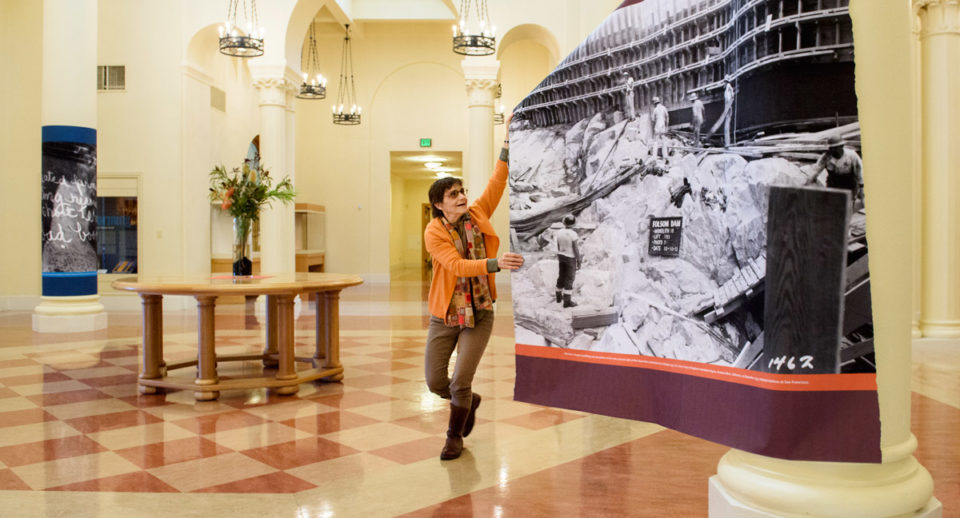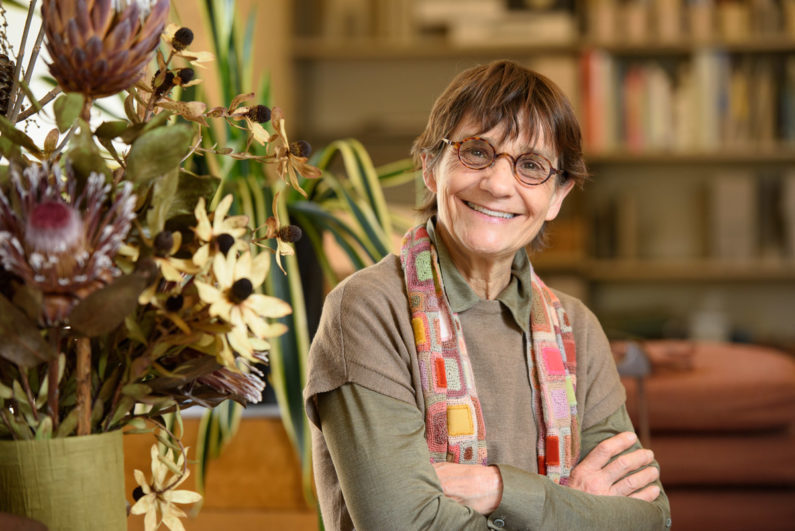Elizabeth Fischbach, a ‘storyteller par excellence,’ wins an Amy J. Blue Award
Fischbach, exhibition designer and manager for Stanford Libraries’ Special Collections, is one of this year’s winners of the Amy J. Blue Award, which honors staff members who are exceptionally dedicated, supportive of colleagues and passionate about their work.
To see the fruits of Elizabeth Fischbach’s labors, one need only ascend the Grand Staircase in the Bing Wing of Green Library, step into the light-filled Munger Rotunda and stroll its perimeter, pausing at illuminated exhibit display cases to contemplate their treasures.
Or wander the adjoining Peterson Gallery, where display cases line the aisles.
As the exhibition designer and manager for Stanford Libraries’ Special Collections, Fischbach, whom everyone knows as “Becky,” shepherds exhibitions from concept to installation.
“Between those points, I work with graduate students, faculty, library colleagues and donors to shape and present the stories they want to tell in the most effective way – given the possibilities and limitations of the space,” she said.
“That’s always a collaboration and is the richest part of the job, but also the most taxing, involving a lot of decisions and negotiations.”
Fischbach plans the layouts of exhibits – both inside and outside the display cases. She designs posters, banners and graphic backdrops, and edits, formats and mounts display text. She builds custom cradles for rare books. Over the years, she has designed and produced more than a dozen print exhibition catalogs.
Fischbach is one of the winners of this year’s Amy J. Blue Award, which honors staff members who are exceptionally dedicated, supportive of colleagues and passionate about their work.
The other two winners are Laura Hubbard, associate director of the Center for African Studies, which coordinates an interdisciplinary program in African Studies for undergraduate and graduate students; and Reyno “Rey” Peralta, lead custodian in Student Housing Operations, a division of Residential & Dining Enterprises.
President Marc Tessier-Lavigne will present the awards at a May 24 ceremony for the winners and their families, friends and colleagues. The ceremony, which begins at 3:30 p.m., will be held in Lagunita Courtyard, located on Santa Teresa Street across from Roble Field. Refreshments will be served.
Dozens of exhibits created
Fischbach, who said it takes more than a year to plan and implement an exhibit, described her job as a combination of graphic designer, project manager and midwife. Over the last three decades, she has delivered more than 90 exhibitions.
Her first installation, Cultural Landscapes: Gilbert White’s Natural History of Selborne, though, met with disaster – natural disaster, that is.
Two days after the exhibit opened, the Loma Prieta earthquake rattled the Bay Area from its epicenter in the Santa Cruz Mountains, wreaking havoc on campus. Inside the rotunda, columns twisted and turned, and giant cracks – some 20 to 30 feet long – snaked across the dome and walls. Though covered in plaster debris, the exhibit cases escaped damage.
In the weeks that followed, Fischbach and her colleagues donned hard hats and set to work moving collections out of the library. In 2001, two years after the Bing Wing reopened, Cultural Landscapes Revisited opened – without incident – in a beautifully restored rotunda.
The path that led Fischbach, ’79, to her current post at Stanford began with an hourly part-time job on campus producing a quarterly catalog of internship opportunities for students. There were stints at Stanford News Service, where she helped design and produce Stanford Report; at the Stanford Oral History Project, where she transcribed interviews; and at University Archives, where she processed student publications.
After serving as a part-time “exhibits coordinator” in Special Collections for a decade, she became its full-time exhibits designer in 1999.
Fischbach does have favorites among the exhibitions she has brought to life. For surprise crowd appeal, The Rise and Fall of the Slide Rule: 350 Years of Mathematical Calculators. For sheer beauty, Zuancho in Kyoto: Textile Design Books for the Kimono Trade. For social and historical relevance, Movements for Change: The Bob Fitch Photography Archive at Stanford.
And she has a long list of “joyful things” she has been able to do because of the work. Among them: learning to hand set type and producing poetry broadsides and chapbooks; hosting a dinner at her home for the Rev. Thomas E. Gilmore, a respected veteran of the civil rights movement; commissioning a cake replica of the Cordillera Blanca mountain range for the opening of All of This I Have Seen: Leigh Ortenburger, Mountaineer and Photographer; and working closely with artists, activists and writers to tell their stories.
Looking back, Fischbach said she is grateful to have been surrounded by books and manuscripts, and by the students, scholars and colleagues who are passionate about them.
“The tangible nature of my work – bringing content to an audience via exhibitions and catalog design – is very satisfying,” she said. “I’m also grateful for the privilege of working with intellectually engaged, creative people, many of whom have become lifelong friends, and one of whom I married.”
Praise from students, faculty, colleagues
In nominating Fischbach for the award, faculty members, students and curators praised her passion, professionalism, enthusiasm, dedication and creativity.
“Becky has an extraordinary visual imagination coupled with exceedingly high technical skills,” said Caroline Winterer, a professor of history and director of the Stanford Humanities Center, who spent a year collaborating with Fischbach on the exhibit, The American Enlightenment: Treasures from the Stanford University Libraries. “Everything she touches turns to gold.”
Benjamin Stone, curator for American and British History, said Fischbach approaches each new exhibit idea with the same level of passion, wonder and invention as the last one.
“Through well-designed exhibit concepts, narratives and cases, she is truly a storyteller par excellence,” Stone said.
Sarah Sussman, curator of French & Italian Collections, said working with Fischbach on the exhibit, Facets of French History, was a wonderful and enriching experience.
“Becky’s clear vision and ease about sharing her opinion about how materials interact together conceptually, visually and aesthetically make the experience of working with her both educational and rewarding,” Sussman said.
University Librarian Michael A. Keller said Fischbach has been “an exceptional and visible partner” to a large number of Stanford students and faculty as she helped them prepare exhibits, and “an exceptional and invisible partner” to many more through those exhibits and through her editorial work for Stanford Libraries.
“One need only see a few of Becky’s exhibits to understand her unusual creativity, always expressed carefully, and with attention to the needs and possibilities of the items in the exhibits,” Keller said. “Becky’s work has never been late, never has needed ‘touch-ups’ and has always brought the spotlight to the curators responsible for the exhibits, whether members of the Libraries’ staff, or students and faculty. Without exception, the exhibits are beautifully prepared with appropriate material and just enough descriptions of each item in each case to lead visitors to the intended narrative of each exhibit. This is both high art and consummate craftsmanship.”
Mackenzie Cooley, a doctoral candidate in history, attributed the success of the exhibit Beasts & Books to Fischbach’s “guidance and creative curatorial talents.”
“In the library entrances, Becky placed life-size bestial monsters from Aldrovandi’s Renaissance writings,” Cooley said. “Every detail was perfect; even the flowers were specially selected to compliment the cases’ contents. From catering at the event to the period at the end of every sentence, Becky’s love of beautiful curiosities and attention to detail showed in every bit of the final product. What is more, perhaps, she taught me what close, creative, critical collaboration could look like.”


